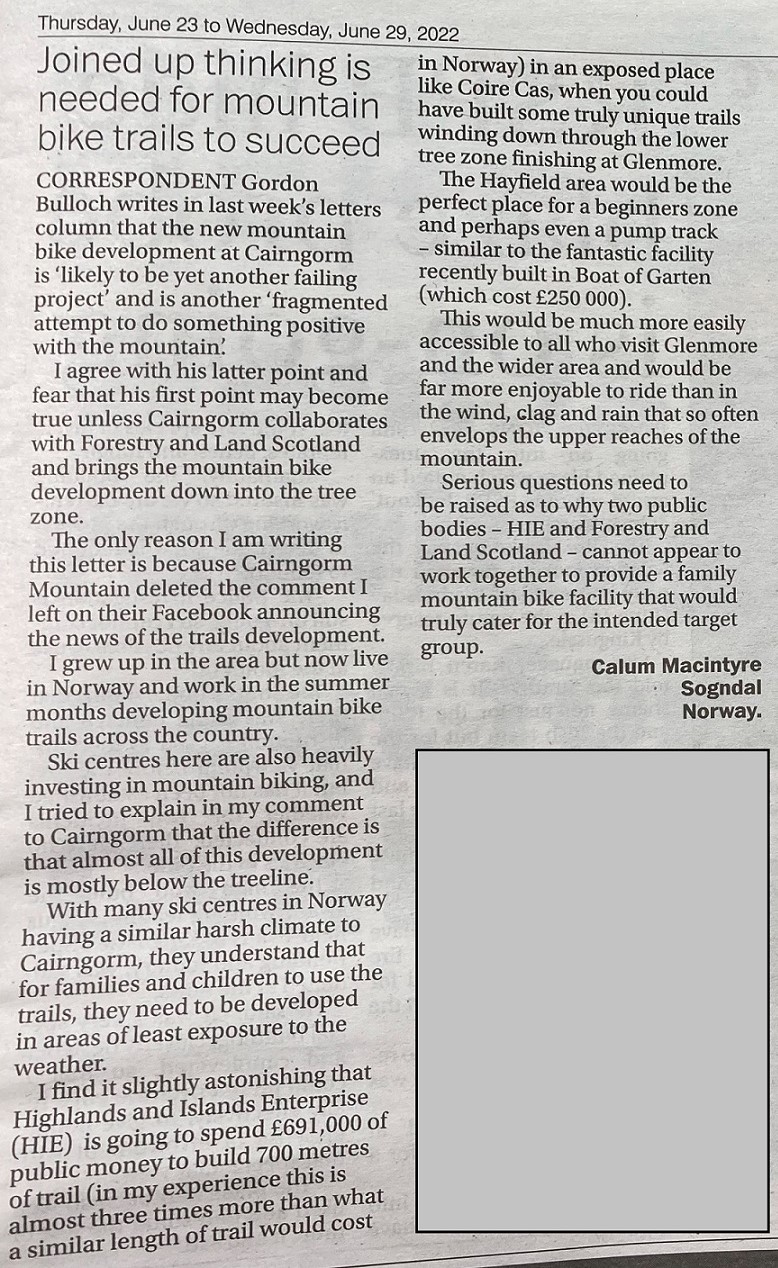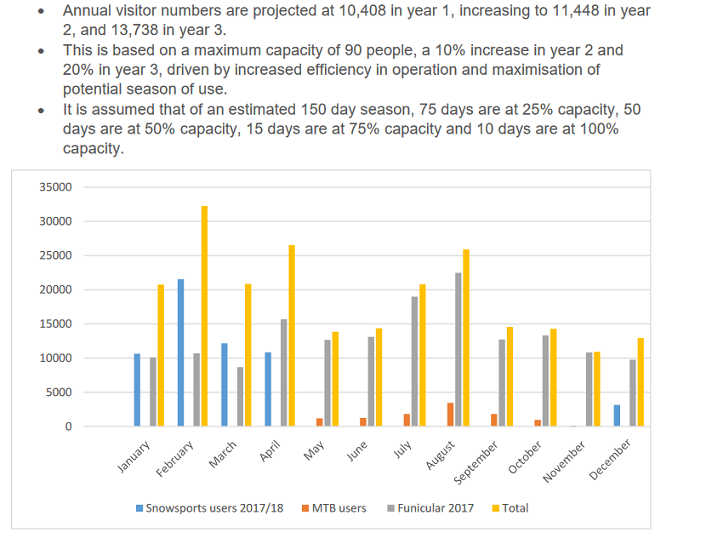
Following my post in March about Highland and Island Enterprise (HIE)’s proposal to build mountain bike tracks at Cairngorm (see here), parkswatch has not considered the matter further. Meantime the Cairngorms National Park Authority (CNPA) considered and approved the application (see here) at the end of May.
I did not watch the planning committee meeting and the CNPA, unlike local authorities, doesn’t leave the recordings on the web for the public to view. This was a shame because I have heard certain board members did themselves proud. Eleanor Mackintosh (previous convener of planning) proposed a motion to reject the application, which had been recommended by officers, and this was seconded by Xander McDade (convener of the CNPA). Extraordinary stuff! They were supported by Pippa Hadley, Derek Ross, Judith Webb, Deirdre Falconer and Fiona Mclean but very narrowly defeated. Unfortunately, Geva Blackett didn’t vote, apparently because she couldn’t hear all the meeting because of a dodgy internet connection and therefore didn’t feel she should, while Carolyn Caddick and Willie Munro were absent. Had they been there, the planning application might have been rejected.
Calum Macintyre’s letter to the Strathy neatly points to two of the fundamental flaws in the application: a good idea but in the wrong place and one supported by surprising large sums of public money.
The letter also illustrates that one of the ways HIE and their subsidiary Cairngorm Mountain Scotland Ltd (CMSL) try to manipulate local opinion is by removing any critical comments from social media under their control. This often works. In the conclusion of their report to the CNPA planning committee (see here). CNPA officers claimed “the proposal to enhance the facilities at the ski centre is welcomed, as evidenced by the supporting letter from the Community Council”. Given most people don’t comment on planning applications (there were two objections and one other set of comments to match the letter of support), social media would have been another way of judging what people really thought. Hence HIE/CMSL’s censorship, hence too this post.
Could mountain biking at Cairn Gorm be made to work?
The idea of turning Cairn Gorm into a family resort is, as Calum Macintyre’s letter argues, daft. The proposal is part of the mindset that believed a funicular railway that would take people up into the wind and the wet was a sensible tourism proposition. After the projected number of visitors never materialised the coach parties, on whom HIE increasingly relied to bring income into Cairn Gorm, also started to desert the funicular. The reason? The touring businesses’ customers responded to requests for feedback by saying saying didn’t enjoy the experience and indicated they preferred Aonach Mor where the gondola station is, more often than not, below the cloud.
While the views from the top of Cairn Gorm can be stunning, the tourist lesson is that good weather never happens often enough to make propositions like the funicular or family mountain biking financially viable.

The vision for mountain biking which HIE set out in their masterplan for Cairn Gorm contained a fundamental contradiction in addition to the tourism wash. An international attraction for mountain biking is a totally different thing to family oriented mountain biking facilities. Aonach Mor, with its challenging downhill trails, definitely comes into the former category. But no family is going to cross the world to experience two 90m magic carpets and a few hundred metres of trails, let alone in the trashed landscape that is Coire Cas.
When this vision was published I interpreted the reference to all-year uplift as being a commitment to install modern lifts capable of being used by both mountain bikers and the snow sports practitioners. It now appears that by all-year uplift HIE was referring to the two magic carpets included in the planning application, which it hopes will be used by family bikers in summer and snowsports beginners in winter. Typically, the planning application never explained how the new mountain bike infrastructure it proposed would work in winter: for example it did not say how the mountain bike trails would fit with a snowsports beginners area or where the snow making machines, required to compensate for the poor snow-holding capacity of lower Coire Cas, will be re-located.
Set all this aside and the key point is that because Cairn Gorm has such harsh weather the people most likely to visit and use any outdoor recreation infrastructure generally need to be tough. That doesn’t preclude families – as an eight year old I learned to ski in blizzards in Cairn Gorm – but the people who want to walk, climb or ski at Cairn Gorm on anything other than the good days tend to have a certain something. As a consequence planning the future of the Cairngorm Mountain business on the creation of beginner facilities, whether for snowsports or mountain biking, is never going to work.
If Cairngorm Mountain is ever to become even a national attraction for mountain biking, therefore, it needs to start with long downhill runs designed for those with experience who are prepared to go out in all weather. That would require the creation of a track or tracks down into Glenmore. And if Cairngorm Mountain as a whole is to have any chance of being financially viable, this needs to be combined with new uplift that can carry mountain bikes when the hill is free of snow, not just April till October as is proposed for the family biking facility.
For this to happen two significant challenges need to be addressed. The first is that any uplift must be designed and managed in a way that prevents it being used to access the Cairn Gorm plateau and the fragile vegetation and soils higher up the mountain. The main concern of the North East Mountain Trust in commenting on the planning application was that any new facilities should not result in this. These issues, however, could be addressed with a little will and if HIE was prepared to work with others instead of acting like the proverbial bull in a china shop. The solution is that integral to the design of any new uplift is that while it must be capable of taking skiers and boarders to the upper slopes, it should be designed to take mountain bikers only part of the way. Exactly where should be an empirical matter, informed by where trails could be created without damaging sensitive ground. That might include, for example, the Shieling in Coire Cas or the heathery shoulder below Sron an Aonaich, which would allow the creation of new trails down into both Coire na Ciste and Coire Cas.
The second challenge is the protected pine wood in Glenmore and capercaillie. Even if one accepts that outdoor recreation poses threats to capercaillie, as is now being claimed, it should still be possible to design a trail that keeps close to the public road and potentially uses part of the old road. That should keep disturbance to a minimum. Moreover, while Aonach Mor now had three downhill bike tracks, they have taken over 20 years to develop. There is no reason why a similar phased approach shouldn’t be taken at Cairn Gorm, with any future extension of mountain bike trails into Glenmore linked to the future of the capercaillie, whose survival in Scotland depends not on the creation of refuges but on suitable habitat being created elsewhere.
The projected number of visitors to the family trails
During the planning process CNPA officers, who have a legal duty to consider the sustainability of proposed developments, did force CMSL to provide information about the number of people they anticipated using the new trails:

The projected number of people using the mountain bike facility has not been arrived at through customer surveys, such as those taken by most tourism businesses, but on capacity. The big idea is the same that lay behind the funicular and more recent proposals to upgrade the Ptarmigan: if a facility is built, the people will come! The whole history of Cairn Gorm under HIE disproves!!
Undaunted, CMSL claim that they will be able to increase capacity further over the first two years through efficiency measures. What are they going to do, speed up the magic carpets?
After starting with capacity, CMSL has modified the projected number of visitors by a number of unexplained assumptions about how much that capacity will be used (the weather is no doubt part of that). For example, CMSL figures show that for no less than half the time, the new facility will be only a quarter full – not that popular then – but makes no mention of these days when the facility won’t operate because of the weather. The good news is that on only 10 days of the year, when the capacity might be 100% utilised, should there be any need to book. Maybe that will result in discounts, as were given to funicular coach parties, to try and draw the families in?
There is no reason to trust any of these figures but at least CNPA has forced HIE to make a commitment by which the success of the venture, if it ever goes ahead, can be judged.
While CMSL provided the CNPA with guesstimates about visitor numbers, it provided no information about the financials including the estimated running costs (power, maintenance, staff) or what families will be charged for the pleasure (which will impact on demand). It is unclear therefore when HIE expects the estimated £691,000 capital costs it has agreed to provide will ever to be repaid let alone whether it will ever start generating an income.
It may not be the CNPA’s primary responsibility to ensure that HIE uses public money wisely – that lies with HIE’s board and Scottish Ministers – but one cannot help but think if just a couple of their own board members had been a little braver last month they might have helped to prevent yet another stupid development at Cairn Gorm that is very unlikely ever to stack up financially.

This is just the latest in a quite lamentable saga. Public money being thrown at CairnGorm that will do little for the commercial sustainability of the business. There are multiple good trails in Rothiemurchus estate that families can ride for free. The trees offer shelter from the wind but there will be no shelter between 2000-2500ft up on the mountain. The projected user numbers have been plucked out of thin air but it’s likely that users will be thin on the ground. Does HIE ever consider the concept of Return on Investment? Will spending almost 700k on this project ever result in a decent return on that investment?